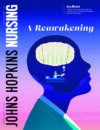Story By Steve St. Angelo | illustrations by Tom Peake
Ready? Count backwards from 100 … 99 … 98 … 97 …
You’ll be asleep long before you run out of reasons why the new Nurse Anesthesia track at the Johns Hopkins School of Nursing is the right program at the right time
The light went on for Bruce Schoneboom, PhD, CRNA, FAAN, as a teenage orderly in the operating room of a hospital where his mother worked as a nurse. “The OR can be a very risky place,” he explains. “And the stakes are high.” In nurse anesthetists, he saw the confidence, the cool, the smarts, and the experience it takes to master ever-changing technology and complex pharmacology, to employ the communication skills to both lead and collaborate, to be the patient’s most staunch advocate, to eliminate risk. “The operating room is a very team-centered environment. As the anesthetist, you’re the member of the team doing the reconnaissance, taking in everything all at once to make sure that the patient is safe.”
“The operating room is a very team-centered environment. As the anesthetist, you’re the member of the team doing the reconnaissance, taking in everything all at once to make sure that the patient is safe.”
And so Schoneboom scoffs at the old joke about the anesthetist who likes his job so much because the patients are always asleep and thus no trouble. “It’s such a unique, one-on-one relationship with your patients,” he says of the role of a certified registered nurse anesthetist (CRNA). “You’ve got to win their trust, often in a very short amount of time. They have to know that you’re not going to abandon them.”
Schoneboom, associate dean for practice, innovation, and leadership, helms the newly launched DNP Advanced Practice Nurse Anesthesiology Program at the Johns Hopkins School of Nursing. (Learn more at nursing.jhu.edu/crna.) And he’s counting down the seconds until the first classes begin in May 2020. A gifted set of applicants will do that for you. “These people are experienced,” he says. “They tend to be a little more mature.”
Good thing. “This program is calibrated to turn out leaders. Our graduates will be ready from Day One to contribute, to succeed, because they have to be,” insists Schoneboom, a retired Army colonel who commanded a surgical hospital on the Afghanistan-Pakistan border in 2006, where he cared for soldiers and provided humanitarian help to local nationals. “It’s just part of the Johns Hopkins brand that our graduates stand out.”
The payoff? Since 2016, CRNA has ranked among U.S. News & World Report’s top career choices for personal satisfaction, collaboration inherent to the job, and unquestioned benefits to health care and society. Hundreds of self-reporting nurse anesthetists gave their profession a perfect score in job satisfaction, according to a 2017 report by Payscale.
Oh, and the money’s not bad either.
Do the Math
CRNAs administer local and general anesthetics; perform epidural, spinal, and nerve blocks; provide “twilight” sedation and pain management. They work in collaboration with surgeons, anesthesiologists, dentists, podiatrists, and other professionals to ensure the safe administration of anesthesia.
According to the American Association of Nurse Anesthetists (AANA) 2016 Practice Profile Survey, they administer more than 43 million anesthetics each year in the U.S. They are relatively independent professionals who have direct reimbursement rights under the Medicare program. They were the first nursing specialty to have this privilege granted by Congress in 1986. Yet nurse anesthetists have had to battle stigma: The AANA has noted that when a nurse anesthetist administers anesthesia, it is considered nursing; by contrast, an anesthesiologist’s work is considered medical practice. There are no procedural differences between the two.
As the AANA reports, the profession arose out of necessity during the Civil War, when nurses jumped in to provide anesthesia as numbers of wounded soldiers became overwhelming.
A similar numbers game exists today in rural and medically underserved areas, where physicians are in short supply. Here, nurses—and in particular, nurse practitioners—have been called upon to provide care across the spectrum.
In fact, CRNAs are the sole providers in nearly 100 percent of rural hospitals for some states. Which makes the demand for nurse anesthetists in such places intense: According to the Bureau of Labor Statistics, Montana ($242,000) and Wyoming ($233,000) top the pay scale for CRNAs. (The latest benefits and compensation survey by the AANA puts the mean CRNA salary at $190,000. By comparison, the Bureau of Labor Statistics lists the 2018 mean salaries of RNs at $72,000 and NPs at $114,000.)
Even where care is more available, CRNAs are making inroads. For a number of years and for many reasons, a nursing shortage has loomed over all of health care in the United States. One of these reasons is a simultaneous shortage of physicians. The Johns Hopkins School of Nursing has embraced the challenge of turning out nurses—NPs, DNPs, and CRNAs—prepared to close that gap.
Such demand offered an opportunity, and planning for a doctorally prepared CRNA program began.
Unrivaled Access
Schoneboom is quick to praise the Johns Hopkins School of Medicine’s Anesthesiology and Critical Care Department (ACCM) as well as other Johns Hopkins Medical Institutions, like the Armstrong Institute for Patient Safety, for recognizing the role JHSON could play in expanding an anesthesiology workforce while also elevating the practice.
“We’re excited to get to rebuild a program with such a rich history.”
“They were the drivers in this,” Schoneboom says of ACCM. “We’re excited to get to rebuild a program with such a rich history,” pointing to nurse anesthetist contributions at Johns Hopkins dating back to the 1920s but which slowed in the 1980s.
The School of Medicine is already ranked #1 for its anesthesiology specialty for 2019–20 by U.S. News & World Report. He explains that access is what pushes the Johns Hopkins DNP Nurse Anesthesiology program out front.
“One thing that’s unique about this program is that it is a partnership, so there will be a lot of different types of experiences for students. … Our students will get to work alongside the giants of the profession,” Schoneboom says. “We’ll be leveraging the clinical expertise that the Johns Hopkins Hospital System brings to the table.” And through the Armstrong Institute’s participation, students’ DNP projects will put them in line “to identify safety and quality problems they’d like to address and to really make an impact.”
What It Takes
The 36-month DNP Advanced Practice Nurse Anesthesiology curriculum emphasizes evidence-based practice, leadership skills, and systems-level thinking. Graduates are prepared to respond to changing technology and health care policy landscapes and to manage anesthesia needs across aging and diverse populations. (Official accreditation is due in January 2020 from the Council on Accreditation of Nurse Anesthesia Educational Programs. To put the JHSON program’s faculty over the top, the school hired Victoria Goode, PhD, CRNA, from Duke University as faculty director and Catherine Horvath, DNP, CRNA, CHSE, from Georgetown University as co-director.)
Schoneboom describes the curriculum as “very basic science-focused. Of course, there will be the physical assessment piece, the pathophysiology, and the pharmacology: The Three P’s of the doctor of nursing practice degree.”
“To be a successful applicant, first of all you need to have done very well on your basic science coursework for your undergraduate degree. The other piece that’s very important is the experience. All qualified applicants at a minimum need to have one year acute ICU experience.”
To be certified as a CRNA, graduates must have over 2,000 hours of clinical experience and have administered over 600 anesthetics in a wide variety of cases. Graduates can apply for certification through the National Board of Certification and Recertification for Nurse Anesthetists.
It’s all a genuine challenge—intentionally so—and Schoneboom knows that becoming a CRNA isn’t for everyone. But he can’t think of anything better: “If you love science, and you love technology, and you love the pharmacology, and you love the one-on-one patient involvement, I get to do all of these, and it makes my job actually fun.”
“If you love science, and you love technology, and you love the pharmacology, and you love the one-on-one patient involvement, I get to do all of these, and it makes my job actually fun.”

